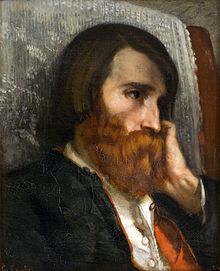Alfred Bruyas
Alfred Bruyas (born August 15, 1821 in Montpellier ; † January 1, 1877 there ), actually Jacques Louis Bruyas, was a French art collector and patron.
Live and act
Bruyas was the son of a wealthy banker in Montpellier. His interest in art began while he was still at school, in 1840 he took lessons in Charles Matet's studio , but soon recognized the limits of his own artistic talent and switched to working as a patron and collector of the art of his time. Since the beginning of the 1840s, his first commissions went to, among others, Auguste Glaize , the brothers Eugène and Achille Devéria , François-Louis Francais , Émile Loubon and Alexandre Cabanel , with whom he frequented the artist circle of the Villa Medici on his first trip to Italy in 1846 , and which he visited again in Rome in 1848.
After arguments with his father, who disapproved of the son's enthusiasm and tried to stop his financial expenses, Bruyas spent most of the time in Paris from 1849 to 1854, frequented the studios and salons there and continued despite the father's Prohibited his work as a promoter and collector. The paintings commissioned or acquired by him during this time include works by Louis Hector Allemand , Camille Corot , Thomas Couture , Eugène Delacroix , Narcisse Diaz de Peña , Adrien Guignet , Adolphe Hervier , Prosper Marilhat , Édouard-Antoine Marsal , Jean-François Millet , Théodore Rousseau , Octave Tassaert , Marcel Verdier and Constant Troyon , but above all Gustave Courbet , who played a central role in Bruya's conception of art and in the program of his collecting activities since 1853. With a feeble constitution, but soigned demeanor, Bruyas exposed himself to the ridicule of the public through the lavish use of his fortune and the large number of portraits he commissioned, although the audience failed to recognize that his patronage was not personal vanity or the need for sophisticated representation served, but was an expression of a selfless commitment to art, which he wanted to recognize at the same time a key role in overcoming the intellectual and social conflicts of the Second Empire .
In 1854 Bruyas returned to Montpellier, followed at his invitation by Courbet, who spent the summer with him. From Montpellier, Bruyas continued to take part in the art life in Paris and in 1855 supported Courbet in its construction of the Pavillon du Réalisme . In 1857 Courbet visited him again in Montpellier, accompanied by the critic Champfleury, who subsequently exposed the mockery of the Parisian art scene through his satirical story Histoire de MT .. in the Revue des Deux Mondes Bruyas and thereby also strained the relationship between Bruyas and Courbet . In the following years, Bruyas devoted himself to completing his collection with works by all the important French artists of his time, whereby he was able to dispose of his father's inheritance without restriction after the death of his father (1863). In 1868 and 1876, he donated significant parts of his collection to the Musée Fabre , where he personally arranged the hanging of the works and, as a curator, cataloged and completed the collection.
Bruyas had accompanied his work as a patron and collector since his first time in Paris with writings on art and carefully compiled catalogs from his collection, which, in addition to the letters received, are important sources for knowing how the works in his collection were created.
Fonts

- Catalog des tableaux, dessins, esquisses, études composant le salon de peinture de M. Alfred Bruyas de Montpellier (1851)
- Salons de peinture de M. Alfred Bruyas (1852)
- L'art Moderne en France, Odyssée de la peinture ou sérieuses recherches sur la vérité et de Salons de peinture de M. Alfred Bruyas (1853)
- Kind of modern. Documents relatifs à la galerie Bruyas (1872)
- Explication des ouvrages de peinture du cabinet de M. Alfred Bruyas (1854)
- Solution d'artiste. Sa profession de foi (1853)
- Le vrai sentiment exclut-il le mot prétention? (1851)
- Galerie Bruyas (1876, together with Théophile Silvestre, unfinished catalog)
literature
- Marion Haedeke Alfred Bruyas: Art- historical study on patronage in the 19th century. Peter Lang, Bern 1980 (= European university publications, 28.14)
Web links
- "Bonjour, Monsieur Courbet!" (May 28, 2003). Dossier on the exhibition at the Musée Fabre in Montpellier, published by the Communauté d'Agglomération de Montpellier (French)
- "Bonjour, Monsieur Courbet!" (May 28, 2003). Dossier on the exhibition at the Musée Fabre in Montpellier, published by the Communauté d'Agglomération de Montpellier (English)
- Thomas Schlesser, Gustave Courbet Fund (PDF; 108 kB): Short biography and description of the autographs and archival material in the Gustave Courbet Fund of the Institut national d'histoire d'art
| personal data | |
|---|---|
| SURNAME | Bruyas, Alfred |
| ALTERNATIVE NAMES | Bruyas, Jacques Louis |
| BRIEF DESCRIPTION | French art collector and patron |
| DATE OF BIRTH | August 15, 1821 |
| PLACE OF BIRTH | Montpellier |
| DATE OF DEATH | January 1, 1877 |
| Place of death | Montpellier |
